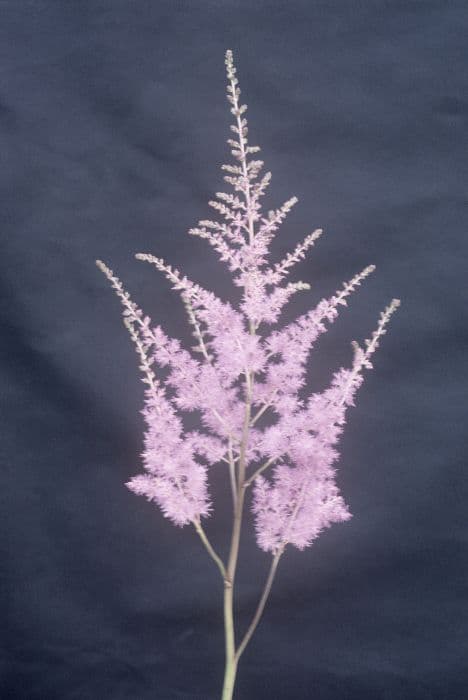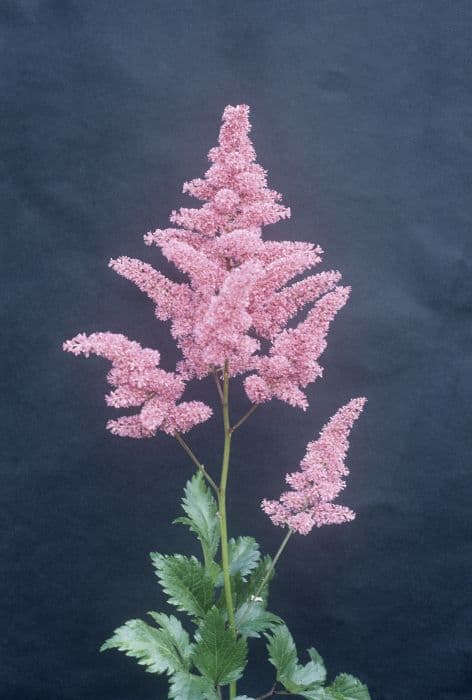White Mountain Saxifrage Saxifraga paniculata var. minutifolia (8)

ABOUT
Saxifraga paniculata var. minutifolia, also widely known as white mountain saxifrage, is a distinctive perennial plant noted for its hardy nature and charming appearance. The plant typically features a dense rosette of fleshy, spoon-shaped leaves that are often a bright green color and may have a slightly reddish tinge at the edges. The leaves are tightly packed at the base of the plant, forming a neat and compact structure. In the flowering season, white mountain saxifrage produces clusters of small, star-shaped flowers. These blooms are usually a crisp white color, though they can sometimes have a hint of pink. The flowers are borne on slender stalks that rise above the foliage, creating an airy effect and adding vertical interest. The plant has a preference for rocky substrates and is often found growing in crevices or alpine rock gardens, where it can showcase its cushion-like mounds dotted with the delicate blooms. The overall appearance of white mountain saxifrage is one of tough elegance, as it endures harsh growing conditions while maintaining its ornamental beauty.
About this plant
 Names
NamesFamily
Saxifragaceae.
Synonyms
White Mountain Saxifrage, Encrusted Saxifrage, Lifelong Saxifrage.
Common names
Saxifraga aizoides var. brevifolia, Saxifraga androsacea, Saxifraga bryoides, Saxifraga caespitosa, Saxifraga cernua, Saxifraga cespitosa, Saxifraga ciliata, Saxifraga cymbalaria, Saxifraga decipiens, Saxifraga geranioides, Saxifraga groenlandica, Saxifraga hirculus, Saxifraga hirta, Saxifraga hypnoides, Saxifraga irrigua, Saxifraga juniperina, Saxifraga moschata, Saxifraga muscoides, Saxifraga nathorstii, Saxifraga nepalensis, Saxifraga nivalis, Saxifraga nivalis var. alpina, Saxifraga nivalis var. hirta, Saxifraga nudicaulis, Saxifraga oppositifolia, Saxifraga paniculata var. brevifolia, Saxifraga paniculata var. geranioides, Saxifraga paniculata var. minutifolia, Saxifraga rivularis, Saxifraga rosacea, Saxifraga rossii, Saxifraga rudolphiana, Saxifraga rupicola, Saxifraga rupifraga, Saxifraga sedoides, Saxifraga serpyllifolia, Saxifraga stellaris, Saxifraga stellaris var. comosa, Saxifraga stellaris var. ciliata, Saxifraga taygetea, Saxifraga tricuspidata, Saxifraga umbrosa.
 Toxicity
ToxicityTo humans
Saxifraga paniculata var. minutifolia is commonly known as White Mountain saxifrage. There is no well-documented evidence to suggest that this particular variety of saxifrage is toxic to humans. Though saxifrages are generally not known for being poisonous, it is always advisable to avoid ingesting plants unless they are known to be edible due to variability in plant chemistry and the potential for individual allergies or unexpected reactions.
To pets
White Mountain saxifrage is not typically known to be toxic to pets. While there is little specific information on the toxicity of Saxifraga paniculata var. minutifolia to animals, saxifrages as a group are generally considered non-toxic. Therefore, it's unlikely that ingesting this plant would cause any significant symptoms of poisoning in pets. Nonetheless, it is still recommended to prevent pets from ingesting plants that are not confirmed to be safe, as individual plants may contain varying levels of substances that could potentially cause mild gastrointestinal upset or allergic reactions in some animals.
 Characteristics
CharacteristicsLife cycle
Perennials
Foliage type
Evergreen
Color of leaves
Green
Flower color
White
Height
6 inches (15 cm)
Spread
12 inches (30 cm)
Plant type
Herb
Hardiness zones
4
Native area
Europe
Benefits
 General Benefits
General Benefits- Aesthetic Appeal: Saxifraga paniculata var. minutifolia, commonly known as alpine saxifrage, adds visual interest to gardens with its rosette-forming habit and delicate blossoms.
- Drought Resistance: Alpine saxifrage is adapted to rocky, alpine environments, making it particularly resistant to drought and suitable for xeriscaping.
- Rock Garden Suitable: Its small size and tolerance for poor soil make it an ideal candidate for rock gardens or for growing in crevices and alpine troughs.
- Cold Tolerance: As an alpine plant, it is capable of withstanding cold temperatures, making it a good choice for gardeners in cooler climates.
- Low Maintenance: Alpine saxifrage typically requires minimal care once established, making it a convenient option for busy gardeners or those looking for low-maintenance landscaping.
- Pollinator Friendly: The flowers of the alpine saxifrage can attract pollinators such as bees and butterflies to the garden, supporting local ecosystems.
- Ground Cover: The dense growth habit of alpine saxifrage can help to suppress weeds and provide an attractive ground cover in suitable garden settings.
- Seasonal Interest: With its early bloom time, typically in the spring or early summer, alpine saxifrage offers seasonal interest by adding color to the garden after the last frost.
 Medical Properties
Medical PropertiesThis plant is not used for medical purposes.
 Air-purifying Qualities
Air-purifying QualitiesThis plant is not specifically known for air purifying qualities.
 Other Uses
Other Uses- Saxifraga paniculata var. minutifolia, also known as White Mountain Saxifrage, can be used as a groundcover in rock gardens due to its dense mat-forming habit, offering an aesthetic appeal with minimal maintenance.
- The plant is often included in alpine and miniature gardening, as it's well-suited to replicate natural mountainous landscapes in a small scale.
- Since White Mountain Saxifrage is tolerant of cold temperatures, it's ideal for creating green roofs in colder climates, providing insulation and habitat without needing extensive care.
- This variety of Saxifrage makes an excellent choice for crevice planting, as it can grow in the tight spaces between rocks, enhancing the natural look of stone walls or pathways.
- Due to its compact form, White Mountain Saxifrage is suitable for container gardening, providing a charming addition to balconies and patios where ground space is limited.
- The plant's blossoms can be used to create a rustic form of jewelry, such as living rings or pendants, when attached with safe adhesives to metal or other durable materials.
- Artists and photographers may use White Mountain Saxifrage as a subject or backdrop due to its distinctive flower clusters and attractive foliage.
- Garden designers utilize this plant for its ability to cover unsightly bare spots in the landscape, filling in areas where other plants may struggle to establish.
- White Mountain Saxifrage can be employed in educational settings as an example of plant adaptation and survival, particularly its ability to thrive in rocky, nutrient-poor soils.
- In regions with native wildlife that includes small mammals and insects, this plant can offer necessary fodder or habitat, contributing to local biodiversity.
Interesting Facts
 Feng Shui
Feng ShuiThe White Mountain Saxifrage is not used in Feng Shui practice.
 Zodiac Sign Compitability
Zodiac Sign CompitabilityThe White Mountain Saxifrage is not used in astrology practice.
 Plant Symbolism
Plant Symbolism- Resilience: Saxifraga paniculata var. minutifolia, commonly known as White Mountain saxifrage, often grows in harsh, rocky environments, symbolizing the ability to thrive under tough conditions.
- Tenacity: With its strong root system that can break through rocks, this plant represents determination and a steadfast nature.
- Purity: The white flowers of the White Mountain saxifrage are often associated with innocence and cleanliness.
- Enduring love: Due to its hardiness and longevity, it can be a symbol of long-lasting relationships that withstand the test of time.
 Water
WaterWhite Mountain saxifrage should be watered sparingly, as it prefers well-drained, moderately moist soil conditions. It's best to water this alpine plant once a week with a gentle soak, ensuring that the soil is moist but not waterlogged. Approximately half a gallon of water per week should suffice, but be sure to adjust the amount based on rainfall and temperature conditions. Overwatering can cause root rot, so it's critical to let the soil dry out slightly between watering sessions.
 Light
LightWhite Mountain saxifrage thrives in partial shade to full sun conditions, making it quite adaptable to different light exposures. However, it performs optimally when provided with morning sun and afternoon shade, especially in regions with hot summers. A northeastern or eastern-facing location that receives bright, indirect light for most of the day is ideal for this plant.
 Temperature
TemperatureWhite Mountain saxifrage is a hardy plant, well-adapted to survive in low temperatures, tolerating a minimum temperature around 10 degrees Fahrenheit. It can withstand temperature extremes up to 80 degrees Fahrenheit, but its ideal growing conditions are within the range of 50 to 70 degrees Fahrenheit. Ensure it is sheltered from harsh winter winds to prevent damage to the foliage.
 Pruning
PruningPruning of the White Mountain saxifrage is primarily for removing dead or damaged leaves and spent flower stalks to maintain its appearance and encourage healthy growth. Prune lightly in the early spring or just after blooming, which is typically in the summer, to remove any undesirable growth. The plant does not require intensive pruning, so this should be done sparingly and only as needed to tidy up the plant.
 Cleaning
CleaningAs needed
 Soil
SoilWhite Mountain saxifrage prefers a soil mix with good drainage, a mix of loam, peat, and sharp grit is ideal. The best soil pH for White Mountain saxifrage is slightly acidic to neutral, ranging from pH 5.5 to 7.0.
 Repotting
RepottingWhite Mountain saxifrage should be repotted every 2-3 years to refresh the soil and prevent overcrowding, ensuring healthy growth and bloom.
 Humidity & Misting
Humidity & MistingWhite Mountain saxifrage thrives in moderate humidity conditions; however, it does not require high humidity and can tolerate levels typical of a household environment.
 Suitable locations
Suitable locationsIndoor
Use well-draining soil; place in bright, indirect light.
Outdoor
Choose a sunny spot, with well-draining soil; protect from hot midday sun.
Hardiness zone
3-8 USDA
 Life cycle
Life cycleSaxifraga paniculata var. minutifolia, commonly known as white mountain saxifrage, begins its life cycle with seed germination, which occurs when environmental conditions such as temperature and moisture are favorable. The seed develops into a young seedling, which establishes itself and begins to grow vegetative parts, primarily leaves and roots. As it matures, it forms a rosette of basal leaves and a sturdy root system, preparing it for subsequent flowering. The plant then enters a reproductive phase, typically in the summer, producing small, star-shaped white flowers atop slender stems, which are pollinated by insects. After successful pollination, fruits develop which contain small seeds that are eventually dispersed by wind, water, or passing animals. The seeds then lie dormant until conditions are right to start the cycle anew, while the parent plant may either die back in harsh conditions or continue its vegetative growth, depending on its perennial nature and the climate of its environment.
 Propogation
PropogationPropogation time
Spring to early summer
Propogation: Saxifraga paniculata var. minutifolia, commonly known as miniature alpine saxifrage, is typically propagated through division. The best time to propagate the plant is in the early spring, as the plant emerges from dormancy and begins to show signs of new growth. To divide the plant, carefully remove it from the ground or its container and gently tease apart the clustered rosettes to create smaller clumps. Each clump should have a section of root attached. These clumps can then be replanted in well-draining soil, spaced about 6 inches (around 15 centimeters) apart to provide them with room to grow. Water these newly planted clumps adequately to help establish the roots in their new locations.









